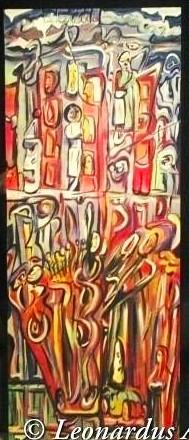'Benevolence' by Leon Aarts acrylics on board (sold)
Leon Aarts—full name Leonardus Aarts, born in 1961 in Christchurch, New Zealand—embodies the restless spirit of abstract expressionism, a style he has honed over more than four decades of dedicated practice. Taught by the influential New Zealand artist Alan Pearson and inspired by his grandfather, the Dutch naive realist Leonardus van de Ven, Aarts channels a blend of emotional intensity and structural experimentation. His works often draw from masters like Brett Whiteley for their feverish distortions and Wassily Kandinsky for their spiritual abstractions, positioning him as a bridge between European heritage and Antipodean innovation. By 2008, Aarts was deep into a phase of exploring human themes through fragmented forms, as seen in pieces like Theatre Reprise (2009) and I AM (2009), where personal and societal narratives dissolve into vibrant chaos. Benevolence (c. 2008), depicted in the provided image, fits this trajectory: a vertical abstraction, likely oil or acrylic on canvas (judging by the viscous brushwork and layered impasto), measuring approximately 24x12 inches. It transforms the concept of kindness into a turbulent visual symphony, framing benevolence not as serene charity but as a fraught, almost apocalyptic force.
Composition and Form: A Vertical Cascade of Turmoil and Reach
The painting's elongated format commands attention like a totem or scroll, drawing the eye downward from ethereal heights to earthly entanglement. At the top, a brooding, inky sky looms with jagged, amorphous shapes—perhaps dangling figures or fractured architecture, evoking a sense of impending descent or divine oversight. This gives way to a midsection of blocky, crimson structures: distorted edifices or humanoid profiles aligned in a row, their "windows" rendered as hollow voids that suggest surveillance or emptiness. The lower third erupts into sinuous, intertwining forms, reminiscent of grasping hands, writhing vines, or flames,curling upward in a gesture of aspiration or supplication. The composition is dynamically unbalanced, with heavy weighting toward the bottom, creating a gravitational pull that mirrors themes of benevolence as both burden and uplift. Aarts employs a Cubist-like fragmentation here, but infuses it with expressionist fluidity: lines bleed and overlap, refusing static geometry in favor of organic flux.
This structure recalls Kandinsky's improvisational rhythms, where forms dance on the edge of recognition, but Aarts grounds it in a more visceral, narrative hint, perhaps a cityscape of souls reaching for grace amid ruin. Compared to his later Building Angles (c. 2010), which favors sharp geometries, Benevolence feels more lyrical, its curves softening the angularity into something almost melodic.
Color and Texture: Fiery Warmth Amid Shadow
Aarts's palette in Benevolence is a blaze of warm tones, dominant reds bleeding into fiery oranges and glowing yellows, set against stark blacks and muted grays in the upper register. This creates a dramatic contrast: the cool, ominous top evokes storm clouds or night, while the heated lower forms pulse with lifeblood energy, symbolizing benevolence as a warming, transformative fire. Colors aren't flatly applied; they're scumbled and glazed, with visible brushstrokes that impart a textured vitality—thick impasto in the swirling bases suggests palpable urgency, as if the paint itself is alive and straining. Subtle whites and creams highlight edges, adding highlights that mimic light breaking through chaos, enhancing the sense of depth without resorting to traditional perspective.
The texture is one of Aarts's hallmarks: rough, layered, and tactile, inviting touch even in a digital view. It echoes Whiteley's expressive mark-making, where surface becomes as narrative as form. A minor quibble: the reds can dominate to the point of muddiness in transitions, potentially overwhelming subtler gradients, but this intensity suits the theme, amplifying benevolence's passionate, sometimes overpowering nature.
Conceptual Depth: Kindness as Cataclysm
Titled Benevolence, the work probes the duality of goodwill, its nurturing essence twisted by human frailty or societal strain. The upper forms might represent authoritative figures or institutions dispensing "benevolence" from on high, while the lower swirls evoke recipients clawing for it, their forms merging in communal ecstasy or agony. Created around 2008, amid global economic unrest and New Zealand's looming seismic vulnerabilities (foreshadowing Christchurch's 2011 earthquake), it resonates as a commentary on fragile human connections: kindness not as passive virtue but as active, chaotic intervention. Aarts, who views himself as a "channel" for soulful expression, infuses the abstraction with spiritual undertones, Kandinsky's influence shines in the emotive color harmonies, while his grandfather's naive realism lurks in the faint figuration, grounding the ethereal in earthly struggle.
Thematically, it aligns with Aarts's broader oeuvre: explorations of identity, emotion, and structure under duress. Unlike his more geometric later works, Benevolence leans organic, perhaps reflecting a transitional period where personal benevolence (toward self or others) battles external forces.
Overall Assessment
Benevolence is a compelling testament to Aarts's prowess, distilling abstract expressionism into a compact inferno of form and feeling, poignant, provocative, and profoundly human. It earns ★★★★½ (4.5/5): near-perfect for its emotional depth and technical verve, with a slight deduction for occasional color saturation that borders on excess. For admirers of Kiwi abstraction or those drawn to art that wrestles with virtue's complexities, it's a standout—raw, resonant, and radiating the artist's unyielding passion. In Aarts's hands, benevolence isn't gentle; it's a storm worth weathering.

